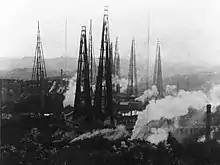History of salt
Salt, also referred to as table salt or by its chemical formula NaCl, is an ionic compound made of sodium and chloride ions. All life has evolved to depend on its chemical properties to survive. It has been used by humans for thousands of years, from food preservation to seasoning. Salt's ability to preserve food was a founding contributor to the development of civilization. It helped eliminate dependence on seasonal availability of food, and made it possible to transport food over large distances. However, salt was often difficult to obtain, so it was a highly valued trade item, and was considered a form of currency by certain peoples. Many salt roads, such as the via Salaria in Italy, had been established by the Bronze Age.
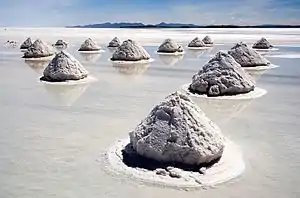
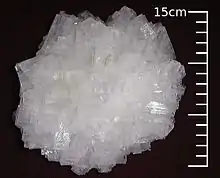
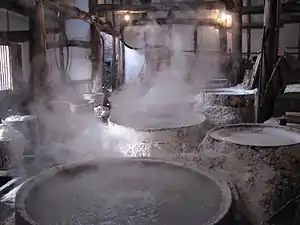
All through history, availability of salt has been pivotal to civilization. In Britain, the suffix "-wich" in a placename means it was once a source of salt, as in Sandwich and Norwich. The Natron Valley was a key region that supported the Egyptian Empire to its north, because it supplied it with a kind of salt that came to be called by its name, natron. Today, salt is almost universally accessible, relatively cheap, and often iodized.
Sources
Salt comes from two main sources: sea water and the sodium chloride mineral halite (also known as rock salt). Rock salt occurs in vast beds of sedimentary evaporite minerals that result from the drying up of enclosed lakes, playas, and seas. Salt beds may be up to 350 m thick and underlie broad areas. In the United States and Canada extensive underground beds extend from the Appalachian basin of western New York through parts of Ontario and under much of the Michigan basin. Other deposits are in Texas, Ohio, Kansas, New Mexico, Nova Scotia, and Saskatchewan. In the United Kingdom underground beds are found in Cheshire and around Droitwich. Salzburg, Austria, was named "the city of salt" for its mines.[1] High-quality rock salt was cut in medieval Transylvania, Maramureş and Southern Poland (Wieliczka). Tuzla in Bosnia and Herzegovina was named in Hungarian Só (salt) from the twelfth century on and later "place of salt" by Turks.
Salt is extracted from underground beds either by mining or by solution mining using water to dissolve the salt. In solution mining the salt reaches the surface as brine, from which the water is evaporated leaving salt crystals.
History
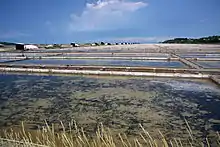
Ancient world
Solnitsata, the earliest known town in Europe, was built around a salt production facility. Located in present-day Bulgaria, the town is thought by archaeologists to have accumulated wealth by supplying salt throughout the Balkans.[2]
Salt was of high value to the Jews, Greeks, Tamils, Chinese, Hittites[3] and other peoples of antiquity. Aside from being a contributing factor in the development of civilization, salt was also used in the military practice of salting the earth by various peoples, beginning with the Assyrians.[4] In the early years of the Roman Republic, with the growth of the city of Rome, roads were built to make transportation of salt to the capital city easier. An example was the Via Salaria (originally a Sabine trail), leading from Rome to the Adriatic Sea. The Adriatic, having a higher salinity due to its shallow depth, had more productive solar ponds compared with those of the Tyrrhenian Sea, much closer to Rome. The word "salary" comes from the Latin word for salt. The persistent modern claim that the Roman Legions were sometimes paid in salt is baseless;[5][6][7] a salārium may have been an allowance paid to Roman soldiers for the purchase of salt, but even that is not well established.[8][9]
During the late Roman Empire and throughout the Middle Ages salt was a precious commodity carried along the salt roads into the heartland of the Germanic tribes. Caravans consisting of as many as forty thousand camels traversed four hundred miles of the Sahara bearing salt to inland markets in the Sahel, sometimes trading salt for slaves: Timbuktu was a noted salt and slave market.[10]
Salt in Chinese history was both a driver of technological development and a stable source of revenue for the imperial government.
Cities and wars
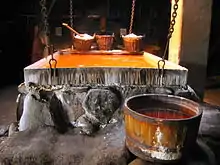
Salt has played a prominent role in determining the power and location of the world's great cities. Liverpool rose from just a small English port to become the prime exporting port for the salt dug in the great Cheshire salt mines and thus became the entrepôt for much of the world's salt in the 19th century.[1]
Salt created and destroyed empires. The salt mines of Poland led to a vast kingdom in the 16th century, only to be demolished when Germans brought in sea salt (which most of the world considered superior to rock salt). Venice fought and won a war with Genoa over spices. However, Genoese Christopher Columbus and Giovanni Caboto would later destroy the Mediterranean trade by introducing the New World to the market.[1]
Cities, states and duchies along the salt roads exacted heavy duties and taxes for the salt passing through their territories. This practice even caused the formation of cities, such as the city of Munich in 1158, when the then Duke of Bavaria, Henry the Lion, decided that the bishops of Freising no longer needed their salt revenue.[1]
The gabelle—a hated French salt tax—was enacted in 1286 and maintained until 1790. Because of the gabelles, common salt was of such a high value that it caused mass population shifts and exodus, attracted invaders and caused wars.[1]
In American history, salt has been a major factor in outcomes of wars. In the Revolutionary War, Loyalists intercepted Patriot salt shipments in an attempt interfere with their ability to preserve food.[1] During the War of 1812, salt brine was used to pay American soldiers in the field, as the federal government was too poor to pay them with money.[11] Before Lewis and Clark set out for the Louisiana Territory, President Jefferson in his address to Congress mentioned a mountain of salt, 180 miles long and 45 wide, supposed to lie near the Missouri River, which would have been of inconceivable value, as a reason for their expedition.[12]
During the Indian independence movement, Mahatma Gandhi organized the Salt Satyagraha protest to demonstrate against the British salt tax.[1]
Salt production in England
Salt was produced from both mines and sea in Medieval England. The open-pan salt making method was used along the Lincolnshire coast and in the saltmarshes of Bitterne Manor on the banks of the River Itchen in Hampshire where salt production was a notable industry.[13]
Wich and wych are names associated (but not exclusively) with brine springs or wells in England. Originally derived from the Latin vicus, meaning "place", by the 11th century use of the 'wich' suffix in placenames was associated with places with a specialised function including that of salt production.[14] Several English places carry the suffix and are historically related to salt, including the four Cheshire 'wiches' of Middlewich, Nantwich, Northwich and Leftwich (a small village south of Northwich), and Droitwich in Worcestershire. Middlewich, Nantwich, Northwich and Droitwich are known as the "Domesday Wiches" due to their mention in the Domesday Book, "an indication of the significance of the salt-working towns in the economy of the region, and indeed of the country".[14] Salt was very important to Europe because it was hard to trade with Africa and they needed to produce it themselves.
Salt trade
Monopolies over salt production and trade were essential aspects of government revenue in imperial China and retained its significance until 20th century.[15][16]
During modern times, it became more profitable to sell salted food than pure salt. Thus sources of food to salt went hand in hand with salt making. The British controlled saltworks in the Bahamas as well as North American cod fisheries.[1] The search for oil in the late 19th and early 20th centuries used the technology and methods pioneered by salt miners, even to the degree that they looked for oil where salt domes were located.[1]
Salt production

On an industrial scale, salt is produced in one of two principal ways: the evaporation of salt water (brine) or by mining. Evaporation can either be solar evaporation[17] or using some heating device.
Solar evaporation of seawater
In the correct climate (one for which the ratio of evaporation to rainfall is suitably high) it is possible to use solar evaporation of sea water to produce salt. Brine is evaporated in a linked set of ponds until the solution is sufficiently concentrated by the final pond so that the salt crystallizes on the pond's floor.
Open pan production from brine
One of the traditional methods of salt production in more temperate climates is using open pans.[18] In open-pan production, salt brine is heated in large, shallow open pans. The earliest examples of this date back to prehistoric times and the pans were made of either a type of ceramic called briquetage, or lead. Later examples were made from iron. This change coincided with a change from wood to coal for the purpose of heating the brine.[19] Brine would be pumped into the pans and concentrated by the heat of the fire burning underneath. As crystals of salt formed, these would be raked out and more brine added.
Closed pan production under vacuum
The open pan salt works has effectively been replaced with a closed pan system where the brine solution is evaporated under a partial vacuum.[20]
Salt mines
In the second half of the 19th century, industrial mining and new drilling techniques made the discovery of more and deeper deposits possible, increasing mine salt's share of the market. Although mining salt was generally more expensive than extracting it from brine via solar evaporation of seawater, the introduction of this new source reduced the price of salt due to a reduction of monopolization. Extraction of salt from brine is still heavily used; for example, vacuum salt produced by British Salt in Middlewich has 57% of the UK market [21] for salt used in cooking.
Other salt uses
The earliest systematic exposition of the different kinds of salts, its uses, and the methods of its extraction was published in China around 2700 BCE. Hippocrates encouraged his fellow healers to use salt water to heal various ailments by immersing their patients in sea water. The ancient Greeks continued this, and in 1753, English author and physician Richard Russell published The Uses of Sea Water in which he declared that salt was a "common defence against the corruption of…bodies" and "contribut[es] greatly to all cures".[22]
In Ethiopia blocks of salt, called amoleh, were carved from the salt pans of the Afar Depression, especially around Lake Afrera, then carried by camel west to Atsbi and Ficho in the highland, whence traders distributed them throughout the rest of Ethiopia, as far south as the Kingdom of Kaffa.[23] These salt blocks served as a form of currency.
See also
- Alberger process
- Bath salts
- Cerro de la Sal (Salt Mountain), Peru
- Fish sauce
- Garum
- Illinois Salines
- International Salt Co. v. United States
- Iodised salt
- James Ford (pirate)
- Joy Morton
- John Crenshaw
- Lüneburg Saltworks
- Mineral lick (salt lick)
- Morton Salt
- Red hill (salt making)
- Saltern
- Salt evaporation pond
- Salt in Cheshire
- Salt industry in Ghana
- Salt in the American Civil War
- Salt March (India)
- Salt Riot (Moscow uprising of 1648)
- Seawater greenhouse
- Anikey Stroganov (Solvychegodsk and Perm salterns)
- Sülze Saltworks
References
- Kurlansky, Mark. Salt: A World History. Penguin Books, 2003 ISBN 0-14-200161-9
- Maugh II, Thomas H. (1 November 2012). "Bulgarians find oldest European town, a salt production center". The Los Angeles Times. Retrieved 1 November 2012.
- Alper Gölbaş (1970-01-01). "Anadolu Kültür Oluşumunda Tuzun Rolü- The Role of Salt in the Formation of the Anatolian Culture | Alper Gölbaş". Academia.edu. Retrieved 2014-05-29.
- Ridley (1986). "To Be Taken with a Pinch of Salt: The Destruction of Carthage". Classical Philology. 81 (2): 140–146.
- Bloch, David. "Economics of NaCl: Salt made the world go round". Mr Block Archive. Retrieved 2006-12-19.
- Bloch, David. "Salt and the evolution of money". Mr Block Archive. Retrieved 2006-12-19.
- "The history of salt production at Droitwich Spa". BBC. 2010-01-21. Retrieved 2011-03-28.
- "salary, n.". Oxford English Dictionary.
- Gainsford, Peter. "Salt and salary: were Roman soldiers paid in salt?". Kiwi Hellenist: Modern Myths about the Ancient World. Retrieved 11 January 2017.
- Rodriguez, Junius P (1997). The Historical Encyclopedia of World Slavery. 2. Santa Barbara, CA: ABC-CLIO. p. 636. ISBN 9780874368857.
- McDowell, Lee. Mineral Nutrition History: The Early Years. Sarasota, FL: Fist Edition Design. p. 46. ISBN 9781506904580.
- "Account of Louisiana". Library of Congress. p. 12. Retrieved 2016-09-10.
- Woolgar, C.M. (2016). The Culture of Food in England, 1200-1500. Yale University Press.
- "Domesday Book". Domesday Book. Archived from the original on 2012-02-27. Retrieved 2012-02-13.
- Flad, Rowan K (2011). Salt Production and Social Hierarchy in Ancient China. Cambridge University Press. p. 36. ISBN 9781139497688.
- Sheng, Hong; Zhao, Nong (2013). China's state-owned enterprises : nature, performance and reform. 1. Singapore: World Scientific. p. 351. ISBN 9789814383844.
- "Solar Salt production". Salt Institute. Archived from the original on 2009-01-31. Retrieved 2006-12-19.
- "Towards an understanding of open pan salt making". Lion Salt Works History & Heritage. Archived from the original on 2006-12-22. Retrieved 2006-12-19.
- "Early Salt Making". Lion Salt Works History & Heritage. Archived from the original on 2006-12-22. Retrieved 2006-12-19.
- "Vacuum Pan Salt Refining". Salt Institute. Archived from the original on 2009-02-02. Retrieved 2006-12-19.
- The Competition Commission. "Factors affecting rivalry in the relevant market prior to the merger" (PDF). British Salt Limited and New Cheshire Salt Works Limited: A report on the acquisition by British Salt Limited of New Cheshire Salt Works Limited. Archived from the original (PDF) on 2007-01-09. Retrieved 2006-09-10.
- Russell, Richard (1753). A dissertation on the use of sea-water in the diseases of the glands. Particularly the scurvy, jaundice, King's-evil, leprosy, and the glandular consumption. London: Owen and Goadby. pp. vi, xii. OCLC 181801978.
- Pankhurst, Richard K. P. (1968). Economic History of Ethiopia. Addis Ababa: Haile Selassie I University.
Further reading
- Salt Institute History of Salt at the Wayback Machine (archived March 3, 2009)
- The Role of Salt in Eastern North American Prehistory
